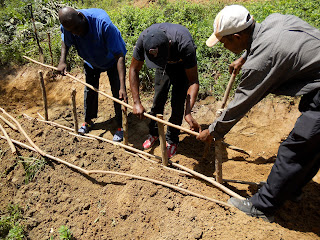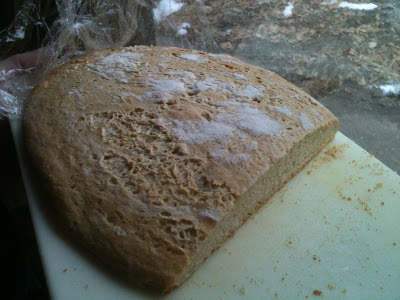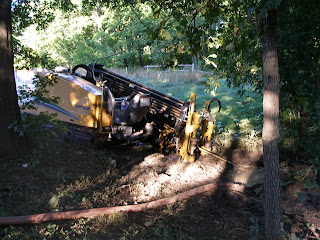Water Breaks, Slowing the Energy and Building Soil.
Many times during the design of swales and berms to collect water, the swales need to be sized for the climate, weather, or the possible extreme precipitation in the area. Soil type also needs to be considered with the slope of the land.
Recently in Haiti we installed a moderate sized swale and berm system to collect water that was running down a ravine. The 3 swales were planted with banana, papaya, and small trees.
Although we've added a 4th swale higher on slope later. The potential rain events and the high quantity of water presented special problems. In the most vulnerable areas of the system, the farmers constructed what I would call a water break.
 The water break system is a line of fresh cut sticks pounded into soil,above and below the swale. They were then weaved with smaller branches. The semi-permeable water break was proven successful the next day when the typical rainstorm dropped 3 to 5 inches of rain within a couple hours. The erosion from the nearby cornfield in the catchment sent sheets of water down the hill filled with silt. Much of the silt filled the swale base at a rate much faster than anticipated.
The water break system is a line of fresh cut sticks pounded into soil,above and below the swale. They were then weaved with smaller branches. The semi-permeable water break was proven successful the next day when the typical rainstorm dropped 3 to 5 inches of rain within a couple hours. The erosion from the nearby cornfield in the catchment sent sheets of water down the hill filled with silt. Much of the silt filled the swale base at a rate much faster than anticipated.
Within a few months the swales would surely be filled and stop collecting water for infiltration. Additional water breaks were added above the swales to slow the water and allow for deposition of the eroded soils prior to entering the swales. The water breaks worked incredibly well as sediment built up behind them. They also caught organic material that filtered even more sediment. It would seem that in time the water breaks would be creating terraces behind them that could be planted with additional crops.
With all this we decided that an additional swale would be added uphill. This swale would be much larger and deeper to collect the local runoff before it entered the cornfield below. The surface runoff above the cornfield was causing a majority of the erosion.
Permaculture solutions are always site-specific. This opportunity in Haiti helped refine our site observations skills and dispel some of our ecological and cultural bias towards past solutions. The recent rainstorms on my own property have been similar to those in Haiti, a thousand of miles away. The discovery and use of these water breaks will be an added feature to trial on our property in areas where water floods in spring and runs during extreme weather events. They are much less disturbing to the soil, yet combined with swales, spread the water evenly across the landscape while filtering out the sediment and organic matter.
Recently in Haiti we installed a moderate sized swale and berm system to collect water that was running down a ravine. The 3 swales were planted with banana, papaya, and small trees.
Although we've added a 4th swale higher on slope later. The potential rain events and the high quantity of water presented special problems. In the most vulnerable areas of the system, the farmers constructed what I would call a water break.
 The water break system is a line of fresh cut sticks pounded into soil,above and below the swale. They were then weaved with smaller branches. The semi-permeable water break was proven successful the next day when the typical rainstorm dropped 3 to 5 inches of rain within a couple hours. The erosion from the nearby cornfield in the catchment sent sheets of water down the hill filled with silt. Much of the silt filled the swale base at a rate much faster than anticipated.
The water break system is a line of fresh cut sticks pounded into soil,above and below the swale. They were then weaved with smaller branches. The semi-permeable water break was proven successful the next day when the typical rainstorm dropped 3 to 5 inches of rain within a couple hours. The erosion from the nearby cornfield in the catchment sent sheets of water down the hill filled with silt. Much of the silt filled the swale base at a rate much faster than anticipated.Within a few months the swales would surely be filled and stop collecting water for infiltration. Additional water breaks were added above the swales to slow the water and allow for deposition of the eroded soils prior to entering the swales. The water breaks worked incredibly well as sediment built up behind them. They also caught organic material that filtered even more sediment. It would seem that in time the water breaks would be creating terraces behind them that could be planted with additional crops.
With all this we decided that an additional swale would be added uphill. This swale would be much larger and deeper to collect the local runoff before it entered the cornfield below. The surface runoff above the cornfield was causing a majority of the erosion.
Permaculture solutions are always site-specific. This opportunity in Haiti helped refine our site observations skills and dispel some of our ecological and cultural bias towards past solutions. The recent rainstorms on my own property have been similar to those in Haiti, a thousand of miles away. The discovery and use of these water breaks will be an added feature to trial on our property in areas where water floods in spring and runs during extreme weather events. They are much less disturbing to the soil, yet combined with swales, spread the water evenly across the landscape while filtering out the sediment and organic matter.




Comments